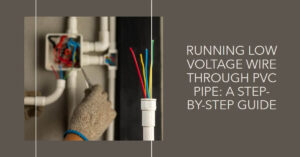When it comes to electrical wiring, understanding wire gauges is crucial for safe and efficient connections.
However, situations may arise where you need to connect wires of different gauges, such as 14 gauge and 16 gauge.
While it is possible to connect wires of different gauges, such as 14 gauge and 16 gauge, it is important to consider several factors. The main consideration is to ensure that the smaller gauge wire can handle the electrical load of the larger gauge wire.
In this article, we will explore the compatibility between these two wire sizes and provide guidance on how to connect them properly.
Understanding Wire Gauge
The definition of wire gauge refers to the measurement of the diameter of a wire. It is represented by a numerical value, where a lower number indicates a thicker wire. The American Wire Gauge (AWG) system is commonly used in the United States to standardize wire sizes.
Importance of wire gauge in electrical connections
The wire gauge is essential for determining the amount of current that can safely flow through a wire.
Using an inappropriate wire gauge for a particular application can lead to issues such as overheating, voltage drop, and potential safety hazards.
Compatibility between 14 Gauge Wire and 16 Gauge Wire
Difference between 14 gauge wire and 16 gauge wire: The primary difference between 14 gauge wire and 16 gauge wire lies in their diameters. A 14-gauge wire has a larger diameter and can handle a higher current compared to a 16-gauge wire. It is important to note that as the wire gauge number decreases, the wire thickness increases.
Factors to consider when connecting different gauge wires: When connecting wires of different gauges, several factors should be taken into consideration.
These include the electrical load, wire length, and the specific application. It is important to ensure that the wire with the smaller gauge can handle the current requirements of the circuit.
Connecting 14 Gauge Wire to 16 Gauge Wire
Evaluation of wire connectors
To connect 14 gauge wire to 16 gauge wire, it is crucial to use appropriate wire connectors. Wire connectors are designed to join wires securely while maintaining electrical conductivity and minimizing the risk of loose connections or short circuits.
It is recommended to use connectors that are specifically designed for connecting wires of different gauges.
Proper techniques for connecting different gauge wires
When connecting wires of different gauges, the following steps should be followed:
- Strip the insulation: Carefully strip about 3/4 inch of insulation from the ends of both wires using a wire stripper, ensuring that no bare wire is exposed beyond the stripped portion.
- Twist the wires together: After stripping the insulation, twist the exposed metal ends of the wires together firmly. This helps establish a solid mechanical connection.
- Secure with a wire connector: Place an appropriate wire connector over the twisted wires, making sure it covers the exposed metal ends completely. Tighten the connector according to the manufacturer’s instructions, ensuring a secure and reliable connection.
Read also my article: Maximizing Convenience: Can You Run an Electric Kettle on a Power Strip?
Potential Risks and Concerns
Overheating and electrical resistance Connecting wires of different gauges can lead to increased electrical resistance and potentially cause overheating.
The smaller gauge wire may not be able to handle the current flowing through the larger gauge wire, resulting in heat buildup and potential damage to the wires or surrounding components.
Safety hazards associated with improper wire connections Improperly connected wires can pose safety hazards such as electrical shocks, fires, or short circuits.
It is crucial to ensure that wire connections are made correctly, following proper techniques and using appropriate connectors.
Best Practices for Wire Connections
Using appropriate wire connectors Selecting the right wire connector is vital for safe and reliable connections between different gauge wires.
It is recommended to consult with a qualified electrician or refer to manufacturer guidelines to ensure the correct connectors are used for the specific wire sizes.
Following electrical code regulations
Adhering to electrical code regulations is crucial for maintaining safety standards. Different jurisdictions may have specific guidelines regarding wire gauge compatibility and connections.
It is important to consult the local electrical code and follow the recommended practices.
Alternative Options
Using wire adapters or pigtails
In some cases, wire adapters or pigtails can be used to connect wires of different gauges. These devices allow for a secure connection between different wire sizes, ensuring proper electrical conductivity and minimizing the risk of overheating.
Upgrading the entire circuit
If the need for connecting different gauge wires arises frequently, it might be advisable to upgrade the entire circuit with wires of the same gauge.
This ensures compatibility and reduces the potential risks associated with mixing wire sizes.
Conclusion
When it comes to connecting wires of different gauges, caution must be exercised to ensure safe and reliable electrical connections.
While it is possible to connect 14 gauge wire to 16 gauge wire, it is crucial to follow proper techniques, use appropriate wire connectors, and consider the potential risks and safety concerns.
It is always recommended to consult a qualified electrician for guidance to ensure compliance with electrical code regulations and to maintain the highest standards of safety in electrical installations.

